Potřebujeme váš souhlas k využití jednotlivých dat, aby se vám mimo jiné mohly ukazovat informace týkající se vašich zájmů. Souhlas udělíte kliknutím na tlačítko „OK“.
ASTM E1038-10(2015)
Standard Test Method for Determining Resistance of Photovoltaic Modules to Hail by Impact with Propelled Ice Balls
Automaticky přeložený název:
Standardní zkušební metoda pro stanovení Odolnost fotovoltaických modulů na Hail nárazem s pohonem Ice Balls
NORMA vydána dne 1.3.2015
Informace o normě:
Označení normy: ASTM E1038-10(2015)
Poznámka: NEPLATNÁ
Datum vydání normy: 1.3.2015
Kód zboží: NS-586075
Počet stran: 4
Přibližná hmotnost: 12 g (0.03 liber)
Země: Americká technická norma
Kategorie: Technické normy ASTM
Kategorie - podobné normy:
Anotace textu normy ASTM E1038-10(2015) :
Keywords:
hail resistance, ice ball impact testing, modules, photovoltaics, solar energy ,, ICS Number Code 27.160 (Solar energy engineering)
Doplňující informace
| Significance and Use | ||||||||
|
4.1 In many geographic areas, there is concern about the effect of falling hail upon photovoltaic modules. This test method may be used to determine the ability of photovoltaic modules to withstand the impact forces of hailstones. In this test method, the ability of a photovoltaic module to withstand hail impact is related to its tested ability to withstand impact from ice balls. The effects of impact may be either physical or electrical degradation of the module. 4.2 This test method describes a standard procedure for mounting the test specimen, conducting the impact test, and reporting the effects. 4.2.1 The procedures for mounting the test specimen are provided to assure that modules are tested in a configuration that relates to their use in a photovoltaic array. 4.2.2 Six or more impact locations are chosen to represent vulnerable sites on modules and general locations are listed in Table 1. Only a single impact is specified at each of the impact locations. 4.2.3 Resultant speed is used to simulate the speed that may be reached by hail accompanied by wind. The resultant speed used in this test method is determined by vector addition of horizontal wind velocity plus vertical ice ball terminal velocity. 4.2.4 Ice balls are used in this test method to simulate hailstones. Hailstones are variable in properties such as shape, density, and frangibility (for fracture characteristics, see Ref (10) in Practice E822). These properties affect factors such as the duration and magnitude of the impulsive force acting on the module and the area over which the impulse is distributed. Ice balls (with a density, frangibility, and terminal velocity near the range of hailstones) are the nearest hailstone approximation known at this time. Ice balls generally are harder and denser than hailstones; therefore, an ice ball simulates the worst case hailstone. Perhaps the major difference between ice balls and hailstones is that hailstones are more variable than ice balls. Ice balls can be uniformly and repeatedly manufactured to assure a projectile with known properties. 4.2.5 Ice balls are directed normal to the surface of a test specimen, which transfers the greatest kinetic energy to the test specimen, unlike a non-normal impact at a glancing angle. 4.3 Data generated using this test method may be used for the following: (1) to evaluate impact resistance of a module, (4.3.1 This test method requires analysis of visual effects, as well as electrical measurements. Visual effects are generally more sensitive than the electrical measurements; therefore, the absolute values for voltage and current are not critical, but repeatable conditions for before and after tests are required for determining electrical changes. 4.3.2 A range of observable effects may be produced by impacting various types of photovoltaic modules. Physical effects on modules may vary from no effect to penetration by the ice ball. Some physical changes in the module may be visible when there is no apparent electrical degradation of the module. 4.3.3 Electrical changes may vary from no effect to no output. All effects of the impacts must be described in the report so that an estimate of their significance can be made. 4.4 This test method does not specify the size or velocity of ice balls or maximum number of impacts to be used in making the test. These determinations will be based on frequency and severity of expected hail occurrences and the intent of the testing. 4.4.1 If the testing is being performed to evaluate impact resistance of a single module, or several modules, it may be desirable to repeat the test using several sizes and velocities of ice balls. In this manner, the different effects of various sizes and velocities of ice balls may be determined. However, no point shall be impacted more than once (see 7.10). 4.4.2 The size and frequency of hail varies significantly among various geographic areas. If testing is being performed to evaluate modules intended for use in a specific geographic area, the ice ball size should correspond to the level of hail impact resistance required for that area. Information on hail size and frequency can be found in Appendix X1 of Practice E822 and footnotes 3 and 4 of this test method, or may be available from local historical weather records. 4.4.3 When testing modules that are designed to be in a stowed position during hail storms, additional impact locations should be chosen accordingly. 4.5 The hail impact resistance of modules may change as the materials are exposed to various environmental factors. This test method may be used to evaluate degradation by comparison of hail impact resistance data measured before and after exposure to other such environmental factors. |
||||||||
| 1. Scope | ||||||||
|
1.1 This test method provides a procedure for determining the ability of photovoltaic modules to withstand impact forces of falling hail. Propelled ice balls are used to simulate falling hailstones. 1.2 This test method defines test specimens and methods for mounting specimens, specifies impact locations on each test specimen, provides an equation for determining the velocity of any size ice ball, provides a method for impacting the test specimens with ice balls, provides a method for determining changes in electrical performance, and specifies parameters that must be recorded and reported. 1.3 This test method does not establish pass or fail levels. The determination of acceptable or unacceptable levels of ice ball impact resistance is beyond the scope of this test method. 1.4 The size of the ice ball to be used in conducting this test is not specified. This test method can be used with various sizes of ice balls. 1.5 This test method may be applied to concentrator and nonconcentrator modules. 1.6 The values stated in SI units are to be regarded as standard. No other units of measurement are included in this standard. 1.7 This standard does not purport to address all of the safety problems, if any, associated with its use. It is the responsibility of the user of this standard to establish appropriate safety and health practices and determine the applicability of regulatory limitations prior to use. For specific precautionary statements, refer to 5.1, Section 6, Note 8, and Note 9. |
||||||||
| 2. Referenced Documents | ||||||||
|
Podobné normy:
Historická
1.2.2015
Historická
1.6.2013
Historická
1.9.2013
Historická
1.12.2012
Historická
1.9.2013
Historická
1.4.2014


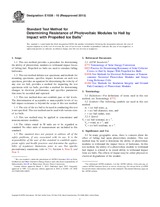
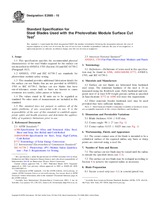 ASTM E2685-15
ASTM E2685-15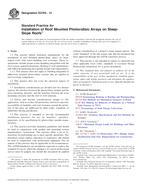 ASTM E2766-13
ASTM E2766-13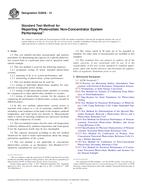 ASTM E2848-13
ASTM E2848-13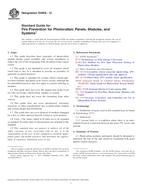 ASTM E2908-12
ASTM E2908-12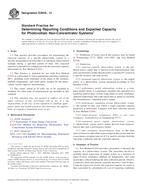 ASTM E2939-13
ASTM E2939-13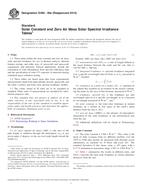 ASTM E490-00a(2014)..
ASTM E490-00a(2014)..
 Cookies
Cookies
